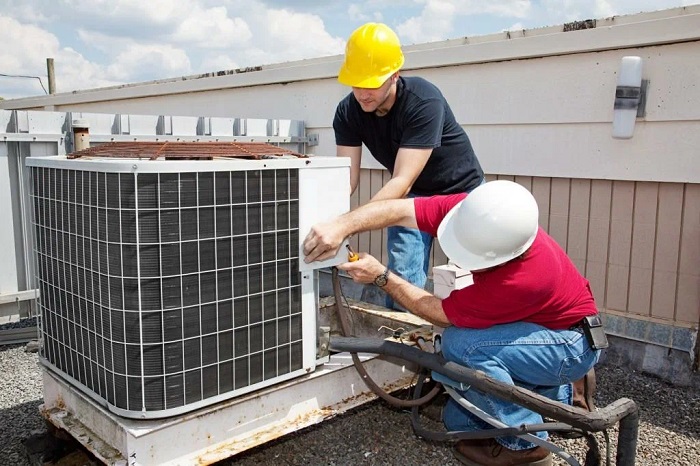What happens when a thermostat fails and how it affects the entire HVAC system

A thermostat seems like a small part of a large HVAC system, yet it controls nearly every function — when the unit starts, how long it runs, and when it stops. When the thermostat begins to fail, the symptoms often appear scattered: uneven temperature, short cycling, or complete lack of response from the furnace or air conditioner. In reality, one inaccurate reading can disrupt the system’s entire balance. Below are real HVAC system repair cases showing how technicians identify thermostat-related issues and restore proper operation.
Case 1: HVAC Unit Runs Constantly Even After Reaching Set Temperature
In one New York apartment, the air conditioner kept running nonstop, even when the room felt cold. The homeowner assumed the compressor was stuck, but testing revealed something different. The thermostat was sending a continuous “cool” signal to the control board because its internal relay was stuck in the closed position. When the technician removed the cover, he found light corrosion and moisture around the contact points. A new digital thermostat was installed, properly wired, and configured with the correct cooling differential. Once calibrated, the compressor started cycling normally again, maintaining steady comfort without overworking.
Continuous operation like this not only wastes energy but can also shorten the lifespan of both compressor and blower motor. The fix was straightforward, but it demonstrated how a small control device can have an outsized effect on performance.
Case 2: Uneven Room Temperature and Delayed Heating
Another case involved a family complaining that one room was always too cold, while another was warm. The furnace responded slowly, taking several minutes to start after temperature changes. The technician measured voltage from the thermostat and discovered irregular readings due to a worn sensor and loose wire connection. The thermostat’s internal temperature sensor was misreading by nearly 5°F. Replacing the unit and ensuring proper wire tension restored balance throughout the home. The new device was also placed slightly farther from a nearby lamp that had been affecting its temperature readings.
Placement of thermostats is often overlooked. If the unit is installed near sunlight, appliances, or vents, the readings become distorted, leading to poor system control even when the HVAC itself is healthy.
Case 3: Short Cycling During Cooling Season
A malfunctioning thermostat can also cause short cycling — when the air conditioner turns on and off rapidly within minutes. In a Manhattan office space, the staff noticed frequent clicks and reduced cooling efficiency. The technician accessed the thermostat’s diagnostic log and saw erratic temperature jumps. The culprit was a failing thermistor that sent fluctuating signals. After replacing the thermostat and programming a minimum runtime delay of five minutes, the compressor began operating with normal, stable cycles.
Short cycling is especially harmful to HVAC systems because each restart puts additional strain on electrical components and reduces dehumidification efficiency. Fixing the thermostat resolved all related issues without touching the air handler or condenser.
Case 4: HVAC System Doesn’t Turn On at All
Sometimes a faulty thermostat prevents the system from starting entirely. In one residential repair, both heating and cooling modes were unresponsive. The homeowner had already replaced batteries and reset settings, but the display stayed blank. Using a multimeter, the technician confirmed 24V power supply from the furnace but no output signal. The backplate contacts had corroded due to condensation. After cleaning the terminals and installing a new programmable thermostat with a sealed base, the system started instantly.
Thermostat connections are small and sensitive. A loose wire or tiny oxidation spot can break communication with the furnace or air handler, making it appear as though the system itself failed. Proper inspection always begins with low-voltage wiring before moving deeper into components.
Case 5: Incorrect Calibration Leading to Inefficient Cooling
In another apartment near Brooklyn, the occupants complained of high electricity bills and discomfort. The HVAC seemed to run longer than needed, yet the air was never quite cold. The thermostat displayed accurate temperature, but the technician compared it with a calibrated digital thermometer and found a 3°F offset. That small deviation made the air conditioner run almost continuously during the day.
Recalibrating the thermostat and adjusting the cooling differential (the temperature gap before restarting) immediately improved performance. Energy consumption dropped the following month by roughly 15%. Sometimes a thermostat doesn’t have to be broken — even a simple miscalibration can waste significant energy.
Case 6: Smart Thermostat Compatibility Issues
Smart thermostats add convenience, but when installed incorrectly, they can create new problems. In one recent case, a homeowner installed a Wi-Fi thermostat without a “C” wire, relying on battery power. The device frequently rebooted, causing irregular temperature swings and unexpected shutdowns. The technician ran a new common wire from the furnace control board, ensuring constant 24V power. Once reconnected, the thermostat maintained stable communication with the HVAC system and stopped rebooting.
Compatibility between thermostat models and HVAC systems is critical. Newer units often require constant voltage for Wi-Fi and display features, while older systems may not supply it. Technicians usually check wiring diagrams before replacement to avoid these mismatches.
Preventive Steps and Recommendations
Thermostats should be tested at least once a year, especially before the start of the heating or cooling season. A few key practices extend their lifespan and ensure reliable operation:
- Keep the device away from heat sources and direct sunlight.
- Clean around the vents and sensor openings to avoid dust buildup.
- Replace batteries annually, even if the screen still shows power.
- Verify calibration with a secondary thermometer.
- If upgrading to a smart thermostat, confirm system compatibility first.
Every HVAC service call begins with one question: Is the thermostat working correctly? The examples above show how a single control fault can mimic compressor failure, fan issues, or refrigerant problems. Understanding the link between thermostat signals and system response helps homeowners detect symptoms early — uneven temperature, non-stop operation, or frequent short cycling are clear signs of trouble.
In most cases, the repair is simple — replace a sensor, clean a connector, recalibrate a display — but the impact is significant. A properly functioning thermostat keeps the system efficient, extends equipment life, and maintains steady comfort throughout every season.













Оставить ответ